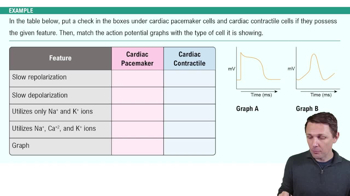Which of the following is longer?
(a) The refractory period of a cardiac contractile cell.
(b) The refractory period of skeletal muscle fiber.
 Verified step by step guidance
Verified step by step guidance Verified video answer for a similar problem:
Verified video answer for a similar problem:



 7:18m
7:18mMaster Introduction to Action Potential in Cardiac Cells with a bite sized video explanation from Bruce Bryan
Start learning